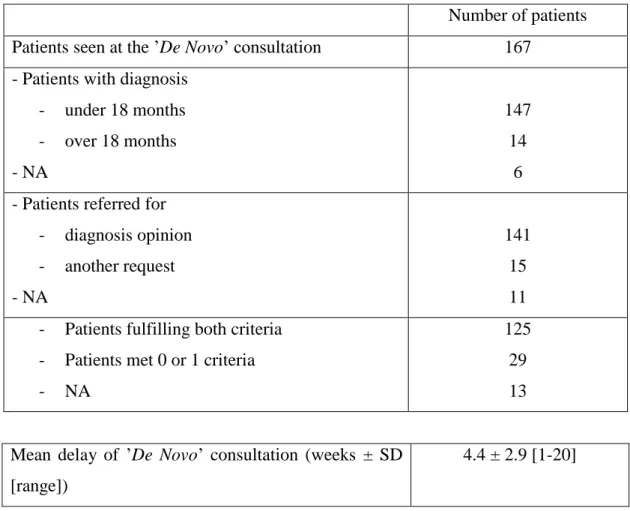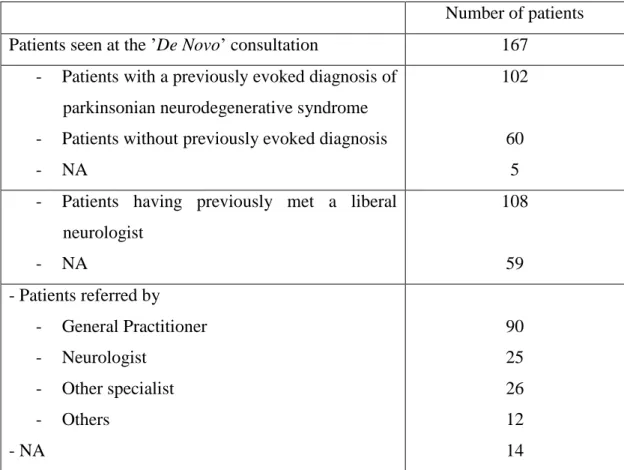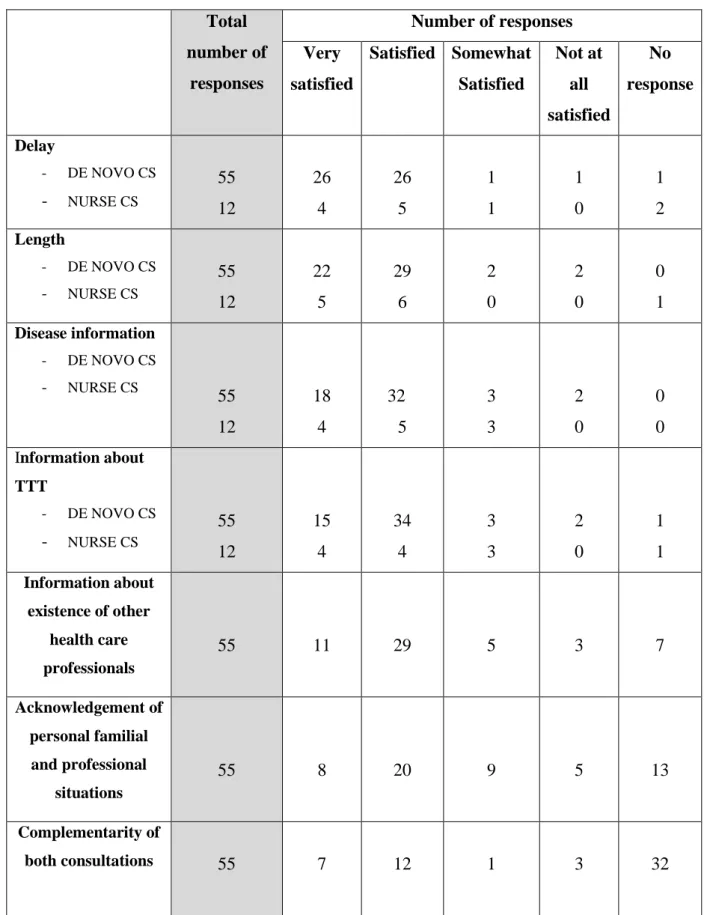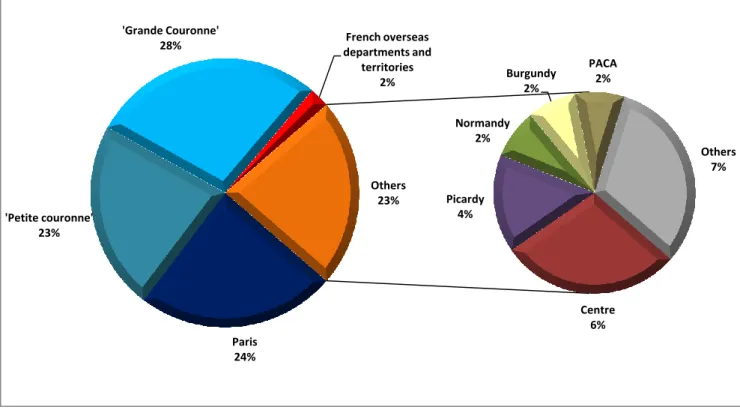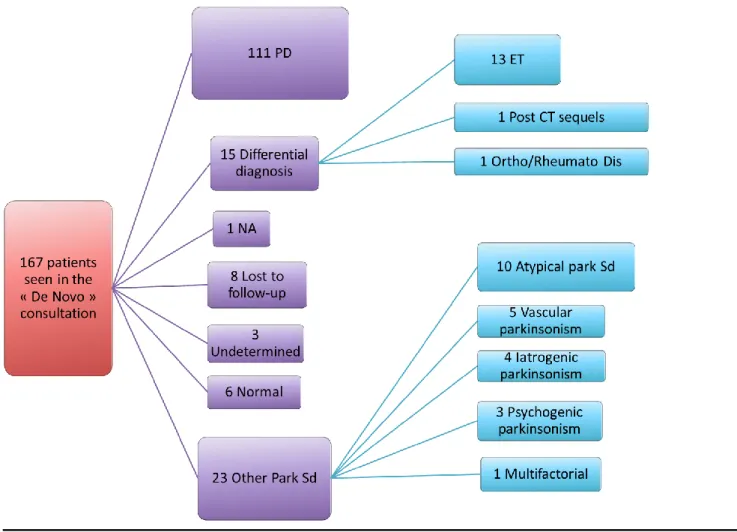Article original
LA CONSULTATION “DE NOVO”: EVALUATION D’UNE CONSULTATION DIAGNOSTIQUE PRÉCOCE DÉDIÉE AUX SYNDROMES PARKINSONIENS
THE ‘DE NOVO’ CONSULTATION: EVALUATION OF AN OUTPATIENT CLINIC DEDICATED TO THE EARLY DIAGNOSIS OF PARKINSONIAN SYNDROMES J. Ruggeri, L.-L. Mariani, S.Aix, A.-M. Bonnet, F. Cormier, J.-C. Corvol, P. Dodet, D. Grabli, A. Hartmann, C. Hubsch, L. Lacomblez, E. Roze, M.-L. Welter, Y. Worbe, M.
Résumé Introduction
En l’absence de signe ou marqueur paraclinique spécifique, le diagnostic des syndromes parkinsoniens peut être difficile, pouvant aboutir à un retard diagnostique et de prise en charge.
Méthodes
Une consultation hebdomadaire spécifique a été mise en place pour confirmer le diagnostic de syndrome parkinsonien. Elle est assurée chaque semaine par des spécialistes de la maladie de Parkinson. Les données issues de la première année de fonctionnement ont été recueillies rétrospectivement et les patients ont complété une enquête de satisfaction. L’objectif principal était de vérifier la faisabilité du dispositif et d’évaluer la satisfaction des patients vis-à-vis de celui-ci.
Résultats
La création de cette consultation spécifique a permis d’assurer des délais de rendez-vous courts de 5 semaines. Une fréquence hebdomadaire et une durée conséquente de consultation ont pu être respectées. Suite à la consultation, le diagnostic clinique de syndrome parkinsonien a été posé ou confirmé chez 80% des patients. Les patients rapportent un niveau de satisfaction élevée (91%) vis-à-vis du délai et du contenu de cette consultation.
Conclusion/Discussion
Notre étude montre qu’une consultation spécifique pour syndromes parkinsoniens avec des délais de rendez-vous rapides, et destinée à donner des avis diagnostiques de recours, est bénéfique pour les patients.
Abstract Introduction
In the absence of specific clinical signs or specific imaging or biomarkers, the differential diagnosis between degenerative parkinsonian syndromes may be difficult at the early stage of the disease. To reduce the risk of misdiagnosis, delayed diagnosis and referral to multiple medical centers at disease onset, easier access to Expert Centers should be offered. To improve the initial care of parkinsonian patients, the Parkinson’s disease Expert Center of Pitié-Salpêtrière Academic Hospital has set up a specific outpatient clinic with short delays dedicated to the diagnosis of early Parkinson’s disease and related disorders.
Methods
First, we identified requests for diagnosis confirmation of parkinsonian syndromes. Then, specific outpatient clinics were scheduled weekly and examination was carried out by neurologists of our Parkinson’s disease Expert Center on a rotation schedule. Data from the first year of rotation were analyzed retrospectively, and a self-administered questionnaire was sent to the patients seen over this period. The main outcomes were to confirm the ability to keep a short delay to patients’ examination and to assess the patients’ satisfaction regarding the set up.
Results
Both study outcomes were reached. The creation of an outpatient clinic dedicated to the early diagnosis of parkinsonian syndromes allowed decreasing the delay to first examination down to 5 weeks instead of several months. The objective of a sustained weekly schedule and length of the visit was reached. Following this outpatient clinic, diagnosis of a parkinsonian syndrome was clinically confirmed or further specified in 80% of patients. Patients’ satisfaction survey showed a satisfaction rate over 91% regarding the delay to and course of the clinical examination in our Parkinson’s disease Expert Center.
Conclusion / Discussion
We report on a quality improvement program in Parkinson’s disease management. Our study shows that a specific consultation with short delays intended to give an early specialized assessment of parkinsonian syndromes is beneficial to the patients and decreases the risk of delayed diagnosis.
Keywords: Parkinson’s disease; parkinsonian syndrome; early diagnosis; patient care management; Expert center
Introduction
One of the main difficulties reported by patients with Parkinson’s disease (PD) and the French National Authority for Health (‘Haute Autorité de Santé’ (HAS)) regarding the integrated health care network for PD, is limited access to an early and accurate diagnosis [1]. PD diagnosis relies on consensual clinical criteria well known to neurologist as defined by national clinical guidelines. However, from the patient point of view, receiving a chronic disease diagnosis such as PD relying solely on clinical criteria can be hard. Most often, information given to the patients does not live up to their expectations, which can impact on the patients’ acceptability, quality of life and adhesion to treatment. During this vulnerable time, increasing access to expertise for patients and providers could reduce the risk of misdiagnosis, delayed diagnosis, multiple investigations and referral to multiple medical centers at disease onset. The diagnostic visit can be a way to offer, depending on the patient’s needs, an additional time for listening, use empathy and words in order to assist the person in his/her future life. This attitude and these words need to account for anxiety, personal representations and knowledge, opinions and personal life experience of the patient and his/her relatives regarding the disease [1]. In addition, it may help to reinforce the confidence in the diagnosis and therapeutic strategy that was proposed by the patient’s doctor and strengthen the trustful patient-doctor relationship.
The 2012-2015 French National Plan to address Parkinson's disease created 25 Regional Experts Centers including seven Inter-Regional Coordination Centers. The main missions of the Parkinson Expert Centers (PECs) are the support of regional integrated health services networks and the management of the regional organization between the range of services involved in the different aspects of care for people with PD and caregivers, from home to ambulatory and inpatients care [2].
Here, we report on the management of patients during diagnosis of PD at its early stages in the Interregional PEC of Pitié-Salpêtrière Academic Hospital in Paris, France. Because of the public knowledge of PEC existence, referrals for a second opinion in patients with early stage PD have dramatically increased making it incompatible with a quick access to expertise and early diagnosis consultation. To improve the initial care of parkinsonian patients, the PEC of Pitié-Salpêtrière Academic Hospital has set up a specific outpatient clinic with short delays dedicated to the diagnosis of early Parkinson’s disease and related disorders. Hence, patients with a suspected degenerative parkinsonian syndrome have a quick access to an ambulatory consultation aimed at confirming or specifying the diagnosis, in order to support first contact networks out of PECs such as neurology practitioners in private practice or hospital
neurologists. It aims at reducing patients’ shortfalls and diagnosis delay and reinforcing their support during initial management of the disease, in order to meet the objective of the French 2014-2019 National Plan against Neurodegenerative diseases to ‘favor the quality of diagnosis and avoid delayed diagnosis’ [3].
In order to assess the efficiency of this new organization, we performed a retrospective study of the characteristics of this ambulatory consultation during the first year after set up. Our goals were to (i) describe the population of patients, (ii) assess the respect of the set up and process criteria and (iii) assess patients’ satisfaction.
Methods
Set up and process description:
The goal was to set up a quick access to an ambulatory consultation with a Parkinson’s disease specialist, in order to support first contact networks out of PECs and organize the post-diagnosis follow up in coordination with the physician that had referred the patient to the Center. The physician referral letter is first screened by the PEC coordinator (B.D.) who checks out the criteria for the ‘de novo’ expert consultation: suspicion of PD or another neurodegenerative parkinsonian syndrome undiagnosed or with a disease evolution since diagnosis of less than 18 months. A ‘De novo’ consultation is then planned with a short delay of less than one month, with a substantial length of 45 min., It is weekly performed over a half-day scheduled time slot by one of the 13 specialized neurologists from the PEC. During this consultation, the neurologist performs a complete clinical assessment aimed at confirming or not, or specifying the diagnosis of parkinsonian syndrome. Detailed information, adapted to the patient’s need and expectations, is given. In case of confirmed neurodegenerative parkinsonian syndrome, the disease mechanisms, treatments, significant comorbidities, scientific research and common misconception are addressed and underlined. A Personalized Health Plan can then be outlined in accordance to the patient’s current and future needs. In case of further questions, during this vulnerable time of new diagnosis, the patient can meet the Parkinson’s disease nurse specialist (PD-Nurse) of the Pitié-Salpêtrière Hospital PEC in a four weeks delay after the initial consultation. This optional nurse consultation is complementary to the ‘De novo’ consultation with the neurologist since the patient can ask new questions that have been raised since the initial consultation and go over and clarify information not properly understood. Global care is also addressed as questions related to daily-living with the disease. Familial and professional situations are talked over. Patients
were also informed that in case of any difficulties or questions, they (or their carers) could contact the PEC by phone or mail.
Study description:
A retrospective study of this ambulatory consultation during its first year after set up was performed. Our goals were to (i) describe the population of patients, (ii) assess the respect of the set up and process criteria described above and (iii) assess patients’ satisfaction.
Regarding the ‘De novo’ consultation characteristics, the number of consultations and their repartition over the year were assessed. Between May 31st of years 2013 and 2014, files were scrutinized for patients’ demographics as well as their integrated services and health care, their physician referral letter and all consultations reports.
Regarding patients’ satisfaction of the neurologist and nurse consultations, to our knowledge, there was no specific scale dedicated to parkinsonian syndromes previously reported. Scales recently published assessing patients’ satisfaction of initial diagnosis consultation in other neurological diseases were scanned and all members from the Pitié-Salpêtrière Hospital PEC were consulted to create an ad hoc self-administered semi-structured questionnaire (Annex 1). A similar approach was used in the diagnosis of cancer by the National Cancer Institute [4]. Our questionnaire consists of 17 questions distributed in 4 parameters: (i) Neurologist consultation (5 questions); (ii) PD-Nurse consultation (6 questions); (iii) Cross-sectional items (4 questions); (iv) Possible improvements (2 questions). Parameters (i) and (ii) are evaluated regarding form (length and localization) and substance (topics addressed during it) of the consultations. Cross-sectional parameter (iii) assesses global satisfaction of the patients regarding both consultations, their complementary aspects and discussed topics. Most of items from parameters (i), (ii) and (iii) are graded as follows: ‘Very Satisfied’, ‘Satisfied’, ‘Somewhat Satisfied’, ‘Not at all Satisfied’. Regarding the possible improvement parameter (iv), patients had the possibility to prioritize from 1 (low priority) to 5 (top priority) the topics that should be addressed during the neurologist and PD-Nurse consultations.
Direct feedback for improvement seemed essential and critical to us. Hence, each of the 4 parameters section contained an open ended question section for potential commentaries. Self-administered questionnaires were mailed to the patients between July and October 2014 with a letter explaining the study (Annex 2) and their answers collected up to December 2014.
Data were collected and analyzed with the Excel software. Patient characteristics are reported as numbers and percentages for categorical variables and medians or mean ± Standard Deviation (SD) [range] for continuous variables.
This project has received the approval of the local Paris 6 Ethics Committee.
Results
During the first year of activity, 49 half-day scheduled time slots were inventoried confirming that the weekly frequency of the consultation was carried on. On these time-slots, 178 patients were assessed. Among them, 1% was seen twice because of a need for reassessment, 2% did not meet inclusion criteria (on-going follow up in the Neurology department or referral for another reason than diagnostic opinion) and 3% did not show up at the consultation. A ‘De
novo’ consultation was performed in 167 patients with a mean of 3.4 ± 1.0 [0-6] patients per
consultation.
Mean delay between the physician’s referral letter and ‘De novo’ consultation was 4.4 ± 2.9 [1-20] weeks with a median of 4 weeks (Table 1). Data for delay was unknown in 19 patients. It is noteworthy that 2 of the patients had asked for a specific delay of consultation (living in another region, planning there consultation after the 4 weeks delay), and 2 other patients had to be rescheduled because of not showing up at the initial consultation.
The majority of patients (75%) originated from the Ile-de-France region; 23% came from another region and 2% from the French overseas departments and territories (Figure 1). Male-to-Female ratio was 1.54; mean age at assessment was 62.6 ± 12.6 [20-89] years old.
Regarding the disease evolution inclusion criteria of neurodegenerative parkinsonian syndrome undiagnosed or with a disease evolution since diagnosis of less than 18 months, 91% met the criteria considering the physician referral letter and/or consultation report, and considering as diagnosed patients when under or previously under anti-parkinsonian medication (Table 1). Regarding the referral inclusion criteria of request for an expert second opinion for the diagnosis of neurodegenerative parkinsonian syndrome, 90% met the criteria (Table 1). Overall, 81% met both criteria, data not being available for 13 out of 167 patients. The physician referral letter is an efficient way to select appropriate patients for the ‘De novo’ process (Table 1).
At referral, diagnosis of neurodegenerative parkinsonian syndrome had already been mentioned in 63% of the patients (Table 2). Sixty-five percent (n=108) of the 167 patients had
previously consulted a neurologist. Patients (n=153) were referred by their general practitioner (GP) in 59% of cases, by a neurologist or other specialist in respectively 16% and 17% of cases, and by others in 8% of cases (data was not available in 14 patients). Thus, only 25 of the 108 patients who had previously met a neurologist were referred to the PEC by the specialist. The majority of patients were referred for a second opinion regarding diagnosis. Data regarding the integrated health care of the patients and their referral are detailed in Table 2.
Following ‘De novo’ consultation, overall diagnosis was confirmed or adjusted in 93% of the patients; additional arguments were needed to confirm diagnosis in 17% through the initiation of antiparkinsonian medication to evaluate L-Dopa-responsiveness or through further investigations (ambulatory or during a short hospitalization) (Figure 2). Figure 2 specifies the diagnosis established in the cohort of patients. Diagnosis of a parkinsonian syndrome was established in 80% of patients: Parkinson’s disease in 66% and another parkinsonian syndrome in 14%. Another diagnosis was made in 9% of cases. Initial clinical examination was normal in 4%. In 2%, further investigations did not allow to establish a precise diagnosis and 5% were lost to follow-up not allowing for a proper diagnosis.
Overall, 10% (n=16) met with the PD-Nurse of the PEC. The majority (69%) of patients were seen within less than 6 weeks.
Accordingly to the inclusion criteria, satisfaction questionnaires were sent to all the patients with a consultation report stating a confirmed diagnosis of neurodegenerative parkinsonian syndrome (n=121/167) (Figure 2). For 8 of them, the mail was returned to sender. The response rate was 48.7% with 55 questionnaires out of 113 answered to and mailed back. The mean delay between the “De novo” consultation and the mailing contact with the patients was of 9 ± 2 months [5-14] (median: 9 months).
Regarding items relative to the delay to and length of the ‘De Novo’ consultation and the information regarding the disease and its treatments, satisfaction rate was over 89% (Table 3). It is noteworthy that 71% were not bothered by the fact that the neurologist they met was not the one originally contacted by their physician in the referral letter.
Among the responsive patients to the questionnaire, 22% had met with the PD-Nurse (Table 3). Seventy-eight percent hadn’t reach out to her and 18% did not fill up the form. The satisfaction rate was over 67%.
Relative to the cross-sectional items, patients were ‘Very Satisfied’ or ‘Satisfied’ with: (1) the quantity and quality of information concerning the existence of other health care professionals
committed to their care for 83% of them; (2) the acknowledgement of their personal familial and professional situations for 67%; (3) the complementarity of both consultations for 83%. A large majority (76%) appraise their questions have been answered to during the consultation(s).
To patients, the most important topics to address during the consultation with the neurologist were the disease mechanisms and treatments, classified as top priority (4 or 5) by respectively 86% and 80% (Table 4). In second place, was coming the acknowledgement of their personal social, familial and professional situations. Then, the information about the existence of other health care professionals committed to their care. The lowest priority was given to a written support. The results relative to topics priority during the PD-Nurse consultation are comparable (Table 4).
Drawbacks of the set up were pointed out in the open ended free commentaries sections. Post-announcement follow-up (delay to next consultation over 6 months, reorientation to proximity health care professionals) was considered insufficient by 22% (n=12/55) but only three of them had met with the PD-Nurse after the neurologist consultation. Expectations regarding general information are not met in 11% (n=6/55) particularly stressing out disease evolution, existing treatments and social repercussions. Delay to ‘De novo’ consultation is also not satisfactory for 9% (n=5/55).
Discussion
Our results confirm the primary outcomes of this ‘De Novo’ consultation set up have been reached. Delay to access to an expert opinion at the PEC has been greatly reduced from the usual 5 months in our Movement Disorder Clinic to less than 5 weeks. According to the latest results reported by the Observatory on Access to Healthcare [5], to reduce the delay to consultation is one of the concerns of French patients since 70% admit having already given up on medical care, among which 67% because of delays to appointment.
In our study, a weekly frequency was organized with a limited number of patients by time slot, ensuring an adapted duration of 45 min for each consultation. This delay has not increased over the year; hence the weekly rhythm of the rotation schedule seems adapted and sustainable. Regarding the few patients with a delay over a month, two limiting steps of the process have been identified: the time for the physician referral letter to get to the hospital and its processing at its arrival in the PEC. In both cases, improving the communication regarding
the dedicated health care network to PD diagnosis could help decreasing the delay, for instance by setting up a dedicated website to the missions and actions of the PEC.
The process defined to identify the eligible patients is efficient since 75% fulfilled the inclusion criteria; the remaining ones presented with a parkinsonian syndrome with a disease evolution of more than 18 months since diagnosis. This issue is due to an absence of disease evolution mentioned in the physician referral letter.
Among the patients in whom a diagnosis of neurodegenerative parkinsonian syndrome had already been mentioned, the vast majority had already met with a neurologist out of the PEC, suggesting that initial diagnosis is usually first given by a specialist. To definitely confirm the final diagnosis of patients, arguments such as evaluation of L-Dopa-responsiveness and additional investigations were necessary in several cases. It reflects the complexity of patients referred to the PEC and its mission to assist in ‘the most complex situations […] needing specialized investigations’ [2]. Despite the frequent referral by a physician, it seems the integrated healthcare network is not always following the coordinated pathway originally planned: GP then neurologist then referral to PEC. The fact that the majority of patients had previously met with a liberal neurologist supports that the PEC fulfills its second line role. However, the majority of them were referred to the ‘De novo’ consultation by their GP and not by their liberal neurologist. It shows the contrast between the real specialist’s need for a second opinion at the PEC and the expectations and demands of the patient reflected by the referral by their GP. The non-respect of the integrated network pathway raises the issue of confidence in the first resort practitioners-to-patient relationship. The PEC mission should help in solving this point.
One of the main drawbacks of our retrospective study is the impossibility to access directly the full content of topics addressed during the ‘De novo’ consultation apart from the written report. Hence, we only sought for patients with a confirmed parkinsonian syndrome to answer the questionnaire. The retrospective aspect of our study could induce an underestimation of the number of patients having met a neurologist and some recall error in filling up the questionnaire.
The study has allowed assessing the very positive global feeling of the patients regarding the ‘De novo’ set up. It has shed some light regarding the various aspects to improve. Patients confirm the important aspects that are information and acknowledgement of their personal social, familial and professional situation as it has also been reported in other studies [6,7],
and in national clinical guidelines [8,9]. Among the dissatisfaction reported, lack of follow up at the PEC after ‘De novo’ consultation is a main complain. The necessity of follow up by a first contact neurologist is inherent to the second resort role of the PEC, having to remain available to all patients on the French territory, making it incompatible to have a multiannual onsite follow up. To clarify the aim of this “De novo” consultation, and prevent dissatisfaction of the patients, it would be important to improve the upstream information regarding it. Therefore, it would be useful to previously send a letter explaining the objectives of this consultation and write information about its purpose on the hospital and the PEC website. PEC intervention is more as a collaborative center in the integrated health care network, and has to reinforce the role of first line contact practitioners back at the center of the network and follow up. Hence, the ‘De novo’ consultation goal was also to support and strengthen the bond between the patient and its caregivers and local practitioners involved in their care.
PD-Nurse consultation allowed going over and clarifying information not properly understood and mention other aspects of care. Primary care providers and physicians can again be identified and if necessary the patient can be oriented towards other new services regarding the various aspects of his care. It is hard to state that dissatisfaction is related to the absence of PD-Nurse consultation but among the patients complaining about the absence of follow up post ‘De novo’ consultation, only three had met with the PD-Nurse specialist. A systematic orientation to the PD-Nurse should be done after diagnosis.
In conclusion, the ‘De novo’ consultation process appears to be a relevant set up as a support and resource for primary care professionals. Relationship with the hospital is improved thanks to a faster access to expertise, improvement of information and feedback, better collaborative work, helping to ensure a more coherent and adapted integrated health care network as requested by the French Ministry of Health (‘Direction Générale de l’Offre de Soins’ (DGOS)) and the guidelines of the French National Authority for Health (‘Haute Autorité de Santé’ (HAS)).
Conflict of interest
None of the authors has any relevant conflict of interest to declare.
References
[1] Haute Autorité de Santé. Guide du parcours de soins : la maladie de Parkinson. HAS 2014. Available at:
http://www.has-sante.fr/portail/jcms/r_1505203/fr/maladie-de-parkinson-parcours-de-soins
[2] Ministère des affaires sociales et de la santé. Cahier des charges - Centres experts régionaux et centres inter régionaux de coordination pour la prise en charge des patients atteints de la maladie de Parkinson ou de syndromes parkinsoniens. 2013.
[3] Ministère des affaires sociales et de la santé. Plan Maladies Neurodégénératives 2014-2019.
Disponible à l’adresse : http://www.gouvernement.fr/action/le-plan-maladies-neuro-degeneratives-2014-2019
[4] Montbel M, Le Borgne V, Bara C, Spire A, Bugat R. Le dispositif d’annonce : le point de vue de l’Institut national du cancer (INCa). Oncologie 2006 ; 8 : 91-3
[5] IFOP pour JALMA. Baromètre de l’accès aux soins Vague 3. 2014.
[6] Institut National du Cancer. Etude sur l’annonce du diagnostic du cancer et le ressenti du malade. 2011.
[7] Cordesse V, Jametal T, Guy C, Lefebvre S, Ruggeri J, Meininger V, et al. Analyse du parcours de santé au cours des maladies neurologiques handicapantes et évolutives. Revue Neurologique 2013 ; 169 : 476-84.
[8] Haute Autorité de Santé. Annoncer une mauvaise nouvelle. HAS 2008.
Available at: http://www.has-sante.fr/portail/jcms/c_698028/fr/annoncer-une-mauvaise-nouvelle
[9] Haute Autorité de Santé. Maladie chronique : Annonce et accompagnement du diagnostic d'un patient ayant une maladie chronique. HAS 2014.
Available at: http://www.has-sante.fr/portail/jcms/c_1730418/fr/annonce-et-accompagnement-du-diagnostic-dun-patient-ayant-une-maladie-chronique
Number of patients
Patients seen at the ’De Novo’ consultation 167
- Patients with diagnosis - under 18 months - over 18 months - NA 147 14 6 - Patients referred for
- diagnosis opinion - another request - NA 141 15 11 - Patients fulfilling both criteria
- Patients met 0 or 1 criteria - NA
125 29 13
Mean delay of ’De Novo’ consultation (weeks ± SD [range])
4.4 ± 2.9 [1-20]
Table 1 : Inclusion criteria fulfillment at the ’De Novo’ consultation NA: data not available
Number of patients
Patients seen at the ’De Novo’ consultation 167
- Patients with a previously evoked diagnosis of parkinsonian neurodegenerative syndrome - Patients without previously evoked diagnosis - NA
102
60 5 - Patients having previously met a liberal
neurologist - NA 108 59 - Patients referred by - General Practitioner - Neurologist - Other specialist - Others - NA 90 25 26 12 14
Table 2 : Characteristics of the integrated health care network of patients seen at the ’De Novo’ consultation
Total number of responses Number of responses Very satisfied Satisfied Somewhat Satisfied Not at all satisfied No response Delay - DE NOVO CS - NURSE CS 55 12 26 4 26 5 1 1 1 0 1 2 Length - DE NOVO CS - NURSE CS 55 12 22 5 29 6 2 0 2 0 0 1 Disease information - DE NOVO CS - NURSE CS 55 12 18 4 32 5 3 3 2 0 0 0 Information about TTT - DE NOVO CS - NURSE CS 55 12 15 4 34 4 3 3 2 0 1 1 Information about existence of other health care professionals 55 11 29 5 3 7 Acknowledgement of personal familial and professional situations 55 8 20 9 5 13 Complementarity of both consultations 55 7 12 1 3 32
DE NOVO CS : ‘De Novo’ consultation; NURSE CS : PD-Nurse consultation; TTT : Treatment Total number of responses Number of responses 5 4 3 2 1 No response Disease information - DE NOVO - CS NURSE CS 55 55 36 16 7 2 2 4 4 5 1 0 5 28 Information about TTT - DE NOVO CS - NURSE CS 55 55 31 18 8 3 6 4 3 1 1 1 6 28 Information about existence of other health care professionals - DE NOVO CS - NURSE CS 55 55 15 8 6 7 15 6 4 3 5 3 10 28 Acknowledgement of personal situations - DE NOVO CS - NURSE CS 55 55 17 13 9 4 9 5 6 3 5 1 9 29 Document written information - DE NOVO CS - NURSE CS 55 55 12 9 4 2 9 7 6 4 10 4 14 29
Tableau 4 : Priority topics
DE NOVO CS : ‘De Novo’ consultation; NURSE CS : Nurse consultation; TTT : Treatment Range from 5 : top priority to 1 : low priority
Figure 1 : Geographical origin of patients
‘Petite couronne’ : 92, 93, 94 departments considered as very close suburbs ; ‘Grande couronne’: 77, 78, 91, 95 departments considered as close suburbs;
Regions of France: Burgundy; Center; Normandy; PACA: Provence Alpes Côte d’Azur; Picardy
Figure 2 : Diagnostic conclusions
PD : Parkinson’s Disease; NA: data not available; Park Sd : Parkinsonian Syndrome ; ET : Essential tremor ; CT : Cranial Traumatism ; Ortho/rheumato Dis : orthopaedic/rheumatologic disorders
Figure 1 : Geographical origin of patients
‘Petite couronne’: 92, 93, 94 departments considered as very close suburbs; ‘Grande couronne’: 77, 78, 91, 95 departments considered as close suburbs;
Regions of France: Burgundy; Centre; Normandy; PACA: Provence Alpes Côte d’Azur; Picardy Paris 24% 'Petite couronne' 23% 'Grande Couronne'
28% departments and French overseas territories 2% Centre 6% Picardy 4% Normandy 2% Burgundy 2% PACA 2% Others 7% Others 23%
Figure 2 : Diagnostic conclusions
PD: Parkinson’s Disease; NA: data not available; Park Sd: Parkinsonian Syndrome; ET: Essential tremor; CT: Cranial Traumatism; Ortho/rheumato Dis: orthopaedic/rheumatologic disorders
